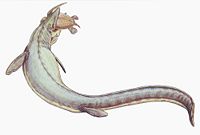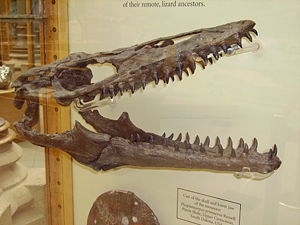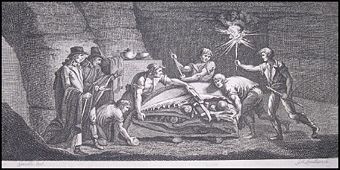Difference between revisions of "Mosasaur" - New World Encyclopedia
Rick Swarts (talk | contribs) |
Rick Swarts (talk | contribs) |
||
| Line 108: | Line 108: | ||
{{reflist|2}} | {{reflist|2}} | ||
| − | * Everhart, M. | + | * Everhart, M. J. 2005a. [http://www.oceansofkansas.com/Greatrep.html Mosasaurs: Last of the great marine reptiles]. ''Oceans of Kansas''. Originally published as Everhart, M. J. 2000. Mosasaurs: Last of the great marine reptiles. ''Prehistoric Times''. 44:29-31. Retrieved May 25, 2008. |
| + | |||
| + | * Everhart, M.J. 2005b. Enter the Mosasaurs. Chapter 9 in M. J. Everhart, ''Oceans of Kansas: A Natural History of the Western Interior Sea''. Bloomington, IN: Indiana University Press. ISBN 0253345472. | ||
* Everhart, M. J. 2008. [http://www.oceansofkansas.com/RapidMosa.html Rapid evolution, diversification, and distribution of mosasaurs (Reptilia; Squamata) prior to the K-T Boundary]. ''Tate 2005 11th Annual Symposium in Paleontology and Geology'', Casper, WY, p. 16-27. Retrieved May 25, 2008. | * Everhart, M. J. 2008. [http://www.oceansofkansas.com/RapidMosa.html Rapid evolution, diversification, and distribution of mosasaurs (Reptilia; Squamata) prior to the K-T Boundary]. ''Tate 2005 11th Annual Symposium in Paleontology and Geology'', Casper, WY, p. 16-27. Retrieved May 25, 2008. | ||
| + | |||
==External links== | ==External links== | ||
Revision as of 22:18, 25 May 2008
| Mosasaurs
| ||||||||||||||
|---|---|---|---|---|---|---|---|---|---|---|---|---|---|---|
 Mosasaurus.
| ||||||||||||||
| Scientific classification | ||||||||||||||
| ||||||||||||||
|
†Halisaurinae |
Mosasaurs (from Latin Mosa meaning the 'Meuse river' in the Netherlands, and Greek sauros meaning 'lizard') were serpentine marine reptiles. The first fossil remains were discovered in a limestone quarry at Maastricht on the Meuse in 1778. These ferocious marine predators are now considered to be the closest relatives of snakes, due to cladistic analysis of symptomatic similarities in jaw and skull anatomies.[1] Mosasaurs were not dinosaurs but lepidosaurs, reptiles with overlapping scales. These predators evolved from semi-aquatic squamates[2] known as the aigialosaurs, close relatives of modern-day monitor lizards, in the Early Cretaceous Period. During the last 20 million years of the Cretaceous Period (Turonian-Maastrichtian), with the extinction of the ichthyosaurs and pliosaurs, mosasaurs became the dominant marine predators.
Known genera include Clidastes, Mosasaurus, Prognathodon, Globidens, Plotosaurus, Plesiotylosaurus, Carinodens, Dallasaurus, Igdamanosaurus, Halisaurus, Tylosaurus, Platecarpus, Selmasaurus, Plioplatecarpus, Amphekepubis, Goronyosaurus, Liodon, Moanasaurus, Pluridens, Lakumasaurus, Yaguarasaurus, Eonatator, Hainosaurus, Tethysaurus, Angolasaurus, Kourisodon and Russellosaurus.
Description
Mosasaurs breathed air and were powerful swimmers that were well-adapted to living in the warm, shallow epicontinental seas prevalent during the Late Cretaceous Period. Mosasaurs were so well adapted to this environment that they gave birth to live young, rather than return to the shore to lay eggs, as sea turtles do.
The smallest-known mosasaur was Carinodens belgicus, which was about 3.0 to 3.5 m long and probably lived in shallow waters near shore, cracking mollusks and sea urchins with its bulbous teeth. Larger mosasaurs were more typical: mosasaurs ranged in size up to 17 m. Hainosaurus holds the record for longest mosasaur, at 17.5 m.
Mosasaurs had a body shape similar to that of modern-day monitor lizards (varanids), but were more elongated and streamlined for swimming. Their limb bones were reduced in length and their paddles were formed by webbing between their elongated digit-bones. Their tails were broad and supplied the locomotive power. This method of locomotion may have been similar to that used by the conger eel or sea snakes today. The animal may have lurked and pounced rapidly and powerfully on passing prey, rather than hunting for it.
Mosasaurs had a double-hinged jaw and flexible skull (much like that of a snake), which enabled them to gulp down their prey almost whole, a snakelike habit that has helped identify the unmasticated gut contents fossilized within mosasaur skeletons. A skeleton of Tylosaurus proriger from South Dakota included remains of the diving seabird Hesperornis, a marine bony fish, a possible shark and another, smaller mosasaur (Clidastes). Mosasaur bones have also been found with shark teeth embedded in them.
Based on features such as the double row of pterygoid ("flanged") teeth on the palate, the double-hinged jaw, modified/reduced limbs and probable methods of locomotion, many researchers believe that snakes and mosasaurs may have had a common ancestor. This theory was first suggested in 1869, by Edward Drinker Cope, who coined the term "Pythonomorpha" to include them. The idea lay dormant for more than a century, before being revived in the 1990s.[3] [4]
Environment
Sea levels were high during the Cretaceous Period, causing marine transgressions in many parts of the world and a great inland seaway in what is now North America. Mosasaur fossils have been found in the Netherlands, in Sweden, in Africa, in Australia, in New Zealand and on Vega Island, off the coast of Antarctica. In Canada and the United States, complete or partial specimens have been found in Alabama, Mississippi, Tennessee, and Georgia and in almost all the states covered by the seaway: Texas, southwest Arkansas, New Mexico, Kansas,[5] Colorado, Nebraska, the Dakotas, Montana, and the Pierre Shale and Fox Hills formations of North Dakota[6]. Mosasaurs are also known from California, Mexico, Peru and Denmark.
Many of the 'dinosaur' remains found on New Zealand—a volcanic island arc that has never been part of a continent—are actually mosasaurs and plesiosaurs, another group of Mesozoic predatory marine reptiles.
Discovery
The first publicized discovery of a fossil mosasaur preceded any dinosaur fossil discoveries and drew the Age of Enlightenment's attention to the existence of fossilized animals; the specimen was discovered in 1780 by quarry-workers in a subterranean gallery of a limestone quarry; they quickly alerted Doctor C. K. Hoffman, a surgeon and fossil-hunter in the Dutch city of Maastricht, although rights of ownership lay with a canon of Maastricht cathedral, as owner of the overlying land.
Dr. Hoffman's correspondence among men of science made the find famous. When the Revolutionary forces occupied Maastricht, the carefully-hidden fossil was uncovered, betrayed, it is said, by a case of wine, and transported to Paris, where Georges Cuvier was able to describe it for science, although le grand animal fossile de Maastricht was not actually described as a Mosasaur ('Meuse reptile') until 1822 and not given its official name, Mosasaurus hoffmanni, until 1829. Several sets of mosasaur remains, that had been discovered earlier at Maastricht but were not identified as mosasaurs until the nineteenth century, have been on display in the Teylers Museum, Haarlem, since about 1770.
The Maastricht limestone beds were rendered so famous by the Mosasaur discovery that they have given their name to the final six-million-year epoch of the Cretaceous, the Maastrichtian.
Evolutionary antecedents
Based on features such as the loosely-hinged jaw, modified/reduced limbs and probable locomotion, many researchers believe that snakes share a common marine ancestry with mosasaurs, a suggestion advanced in 1869, by Edward Drinker Cope, who coined the term "Pythonomorpha" to unite them. The idea lay dormant for more than a century, to be revived in the 1990s.[3] Recently, the discovery of Najash rionegrina, a fossorial snake from South America cast doubt on the marine origin theory.
On 2005-11-16, research reported in Netherlands Journal of Geosciences, confirmed that the recently uncovered Dallasaurus turneri is an early link between land-based monitor lizards (such as the Komodo dragon) and the aquatic mosasaurs.[7]
In popular culture
Mosasaurs appear in the BBC television series Sea Monsters. Mosasaurs also feature heavily in the ITV television series Primeval. In this show, the mosasaurs are depicted incorrectly as having skin more similar to a crocodile's.
A highly evolved mosasaur appeared in an episode of Godzilla: The Series. It was inhabiting Loch Ness as the legendary Loch Ness Monster.
The IMAX 3D film "Sea Monsters" features mosasaurs (including Tylosaurus) with detailed animated recreations of their movements and activities.
Alleged living mosasaurs
{{#invoke:Message box|ambox}} Although paleontologists have determined that all mosasaurs went extinct around the same time as the dinosaurs, and there is no fossil evidence of them beyond the end of the Cretaceous (Maastrichtian), some cryptozoologists feel that sporadic reports of crocodile-like sea serpents may be surviving mosasaurs [citation needed]. The Taniwha of Māori lore has also been connected to mosasaurs by journalists [citation needed]. However, there is no scientific evidence of any mosasaur remains since the end of the Cretaceous, 65 million years ago.
Taxonomy
- Family Mosasauridae
- Subfamily Tylosaurinae
- Hainosaurus
- Tylosaurus
- Taniwhasaurus
- Lakumasaurus
- Subfamily Plioplatecarpinae
- Platecarpus
- Angolasaurus
- Ectenosaurus
- Selmasaurus
- Igdamanosaurus
- Yaguarasaurus
- Plioplatecarpus
- Subfamily Mosasaurinae
- Dallasaurus
- Clidastes
- Mosasaurus
- Moanasaurus
- Amphekepubis
- Plotosaurus
- Globidens
- Prognathodon
- Plesiotylosaurus
- Carinodens
- Subfamily Halisaurinae
- Eonatator
- Halisaurus
- Subfamily Tylosaurinae
Incertae sedis
- Liodon
- Goronyosaurus
- Pluridens
- Kourisodon
- Russellosaurus
- Tethysaurus
ReferencesISBN links support NWE through referral fees
- ↑ Michael S.Y. Lee, 1997, "The phylogeny of varanoid lizards and the affinities of snakes," in Philosophical Transactions of the Royal Society London 352 (January 1997:53-91); on-line abstract.
- ↑ Squamates consist of the living varanoid lizards, snakes and their fossil relatives the mosasaurs.
- ↑ 3.0 3.1 Palaeos Vertebrates 260.100 Pythonomorpha: Pythonomorpha
- ↑ Mosasaurs: Last of the Great Marine Reptiles
- ↑ Everhart, M.J. 2005. "Enter the Mosasaurs," Chapter 9 in "Oceans of Kansas: A Natural History of the Western Interior Sea." Indiana University Press, Bloomington, 322 p.
- ↑ Getman, Myron RC. 1994. "Occurrences of Mosasaur and other reptilian fossil remains from the Fox Hills Formation (Maastrichtian: late Cretaceous) of North Dakota". St. Lawrence University Press.
- ↑ Dallasaurus / Ancient Mosasaur - Dallasaurus - SMU
- Everhart, M. J. 2005a. Mosasaurs: Last of the great marine reptiles. Oceans of Kansas. Originally published as Everhart, M. J. 2000. Mosasaurs: Last of the great marine reptiles. Prehistoric Times. 44:29-31. Retrieved May 25, 2008.
- Everhart, M.J. 2005b. Enter the Mosasaurs. Chapter 9 in M. J. Everhart, Oceans of Kansas: A Natural History of the Western Interior Sea. Bloomington, IN: Indiana University Press. ISBN 0253345472.
- Everhart, M. J. 2008. Rapid evolution, diversification, and distribution of mosasaurs (Reptilia; Squamata) prior to the K-T Boundary. Tate 2005 11th Annual Symposium in Paleontology and Geology, Casper, WY, p. 16-27. Retrieved May 25, 2008.
External links
- Palaeos: Vertebrates: Mosasaurs
- BBC Science and Nature: Mosasaurs
- Mike Everhart and David Lewis, "Mesozoic marine monsters of the Mangahouanga": New Zealand fossil fauna
- Mike Everhart, "A day in the life of a Mosasaur": life in the Sea of Kansas, illus. by Carl Buell
- Mike Everhart, "Mosasaurus hoffmani" until 1829.
- Mosasaurus maximus mounted skeleton at University of Texas Memorial Museum
- Canadian Fossil Discovery Centre
- "The Mosasaur of Maastricht" by Hennie Reuvers in Crossroads web magazine
Credits
New World Encyclopedia writers and editors rewrote and completed the Wikipedia article in accordance with New World Encyclopedia standards. This article abides by terms of the Creative Commons CC-by-sa 3.0 License (CC-by-sa), which may be used and disseminated with proper attribution. Credit is due under the terms of this license that can reference both the New World Encyclopedia contributors and the selfless volunteer contributors of the Wikimedia Foundation. To cite this article click here for a list of acceptable citing formats.The history of earlier contributions by wikipedians is accessible to researchers here:
The history of this article since it was imported to New World Encyclopedia:
Note: Some restrictions may apply to use of individual images which are separately licensed.


